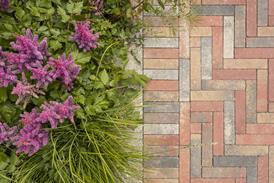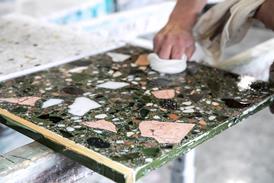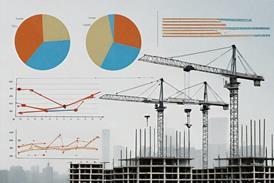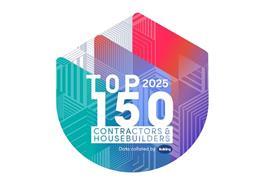Naturally enough, the pervasiveness of ‘phones is lining some companies’ pockets with gold. Increasingly, though, the success stories of mobile phones are not the lumbering corporations that made money from telecoms in the past. Instead, a new high technology jet-set is emerging: lean, fleet of foot, and forward-focused.
One such company is Cellular Operations, which provides telephone helpdesk services and a distribution centre for household names like Cellnet. The firm has grown rapidly since 1998, and now employs more than 200 people.
The expansion meant Cellular Operations’ offices were becoming constrained, and the company was unable to maintain communication between work teams because they were in different buildings or on different floors. It resolved to commission its own building, using developer Highbridge Properties to oversee design and construction.
Cellular Operations and Highbridge approached Richard Hywel Evans to work as architect, purchasing a greenfield site in Hillmead on the M4. On the western side of Swindon, this was just three miles away from the company’s existing offices.
James Ross from consulting engineer Curona Design described the project as “developer-led”: Highbridge and Cellular Operations were active participants in design meetings and, more importantly, they were enthusiastic about pushing the design envelope. “The building had to be innovative,” said Ross, “the developer didn’t want something that someone else had already done.” The main incentive for this stance was to attract high calibre staff – Cellular Operations believed that many potential employees would be seduced by an original, high quality building.
Curona was employed by Highbridge rather than Cellular Operations. Highbridge also let a sub-contract for the services design and build to Pel Building Services, who later employed Primary Colours as the mechanical consulting engineer.
There was no written brief at the outset, and the design team pinpointed the client’s requirements through discussion with Highbridge. The architect came up with a bold two-piece design: an opaque curtain wall block to the south, with a north-facing protrusion in the shape of a jutting glass ‘nose’.
Most of the taller, heavier south block is black. Opaque white cladding panels, fitted where you would normally expect windows, help to keep down solar gains. Job architect Simon Leslie explained that the colour contrast on this side follows a “technical aesthetic”, “inspired by the microchip”.
The transparent glass nose, by contrast, curves in two dimensions. Seamless flat panels are supported by tubular steel and spider clamps. Leslie said it “suggests the organic shape of [the tenant’s] product: mobile phones”.
A shiny spaceship
Approaching from outside, the building resembles a grounded spaceship. Shiny and futuristic, the rounded glazing wraps up cockpit-like to meet the chunkier black block. Brise soleils on the roof could almost double as spoilers for stable interstellar flight.
Boulders surround the building at ground level, reinforcing the space travel image – they suggest it is hovering a little above ground. This is a legacy of the original natural ventilation concept. Air was to have entered the building through the boulders, benefiting from some stored cool thermal energy acquired overnight.
The glazed ‘nose’ of the spaceship is set aside for break-out spaces. These interactive spaces will replace traditional meeting rooms, but are less formal to encourage creative thinking.
Curona’s James Ross said understatedly that the glazing system is “rather special”. This is no off-the-shelf system. It was bespoke manufactured from Pilkington glass, and Buro Happold was responsible for structural design and detailing the facade. At the architect’s insistence, the glazing is clear: Richard Howell Evans wanted to preserve its transparency. Inevitably, though, with this much glass, there is a danger of downdrafts in winter and overheating in summer. To help limit this risk low-emissivity glass is used: it transmits 1·4-1·5 W/m2K.
Despite the area of glass, though, the solar gains are expected to be minimal. “Most of the glazing is shaded by the [solid box] to the south,” said Ross. “It didn’t need extra insulation to meet the Building Regulations.” The engineers allowed for 0·25 air changes/h in summer from unplanned infiltration, rising to 0·5 ac/h in winter, which seems rather optimistic. Sadly, there is no plan to pressure test, so the true infiltration rate will never be known.
Let’s look around
Visitors enter the building close to its western tip – through a discreet opening in the glazed facade. The reception area leads them past a shiny metal ‘bar’ that wouldn’t be out of place in a Star Trek set, and on through the long break-out area beneath the glazed nose.
From here, visitors can either dive straight into the hive of activity in this floor’s dense telephone-computer workspaces, or climb curvy stairs with blue fluorescent lamps buried in each step. All three floors take Trekkie-type design cues: anodised finishes abound and there’s barely a straight line in sight.
All levels have narrow slots piercing through the opaque south facade at desk level to allow external views – so preserving some contact between occupants and outside.
Architect Simon Leslie said the interior is “a celebration of working”, a move away from the cliché of call centres as “modern sweatshops”. Break-out areas were important, he said, and they were given special attention to make them feel relaxed.
Noise was also an important consideration in the office areas. Perhaps surprisingly, though, keeping the spaces as quiet as possible was less important than maintaining some background noise for privacy. When employees spend most of their time answering telephone calls, it better to have a background 38-40 dB – so they are not distracted by their neighbours’ voices.
Services unwrapped
The ventilation strategies for offices and break-out areas are similar. Early design work assumed one person/10 m2, with gains of 40 W/m2 from equipment and lights, and around-the-clock use.
Curona originally modelled a displacement system alone for the office areas, aiming at maintaining about 23ºC. But the developer wanted a very stable temperature – insisting on good control as well as good energy efficiency – so rejected the initial displacement design. This led Curona towards chilled beams for office areas, working in tandem with the displacement system.
Internal design temperatures are tighter than most office buildings with displacement ventilation. The client wanted an average 22ºC across the office areas in summer, although he accepted that the north side of the office – near the glazed nose – would be warmer than the better-insulated south side.
The building was split into ten zones for ventilation, with each served by an independent air handling unit housed on the roof. Seven of the ahus serve the main office area, while the three remaining units take air to and from the nose.
The displacement ventilation system uses 450 mm floor voids to take air into offices through swirl diffusers on each level. These provide low velocity air at less than 2·5 m/s. Stale air is removed from all levels at the top of the breakout nose – where the glazing meets cladding – via a continuous plenum running the length of the building. From here it goes back to a roof-mounted air handling unit, to be recirculated or rejected outside.
The building energy management system controls how much air is recirculated: from 0-90%. It compares internal and external temperatures to determine what supply air temperature is needed, and can bring in 100% fresh air if ambient temperatures suit conditions inside.
As well as the floor void, offices have a slim (150 mm) suspended ceiling to conceal cold water circuits and lighting cables. Onto this are mounted chilled beam casings made by SAS, bringing together passive chilled beams from Waterloo and Luxonic light fittings. The chilled beam casings are continuous, 4 m-wide units, installed three abreast.
Employing chilled beams meant that Curona could use a higher water temperature than conventional cooling systems, bringing energy efficiency dividends. On top of this, the designers anticipate that the chilled beams will only be needed in peak hours: when ambient temperatures are high, and/or when the building is fully occupied.
Curona had considered using a natural lake on the building’s north side to help cool the chilled beams. It would have needed a permit to extract water for this, though, which could have taken up to six months. Curona couldn’t afford this delay and still complete within the allowable timeframe.
Consequently, the design team shifted away from using the lake as a heat dump and instead went for a more conventional, central plant solution. Energy remained a concern, however, and Curona said the building makes full use of night and “free” cooling.
The central plant consists of an eight stage roof-mounted condenser, linked to a three-port mixing arrangement. This sends water at 14ºC into the chilled beam circuit. Humidity sensors around the building spot potential problems before condensation appears on the beams, and cuts off the chilled beams accordingly. Ross said, though, that for this type of building there is a very low risk of humidity ever reaching dewpoint and condensing.
Because a training room on the second floor will be used intensively, Curona felt chilled beams would not give sufficient control over conditions. Instead, two Daikin chillers, rated at 688 kW, are used for cooling.
According to Curona’s calculations, outside air may be used to cool water without using compressors for about 80% of the year. This clearly wasn’t happening on the day of visit though, for the compressors were running, seemingly wrestling against all four modular boilers. Let’s hope the commissioning – delayed by some hiccups on site – irons out this wasteful operation.
Bizarrely, the client wanted the facility to offer higher winter temperatures than summer ones. Thus the four 200 kW boilers were sized to guarantee 23ºC in the winter – a degree more than the summer average. John Hauton from Primary Colours, consultant to the services contractor, said the boilers were also sized to have 25% spare capacity as a requirement of the contract. Presumably, Cellular Operations wanted to future-proof services in case it needs to extend the building.
Solar gains through the north-facing glass nose are minimal through most of the day, but may become considerable in the afternoon at the western tip, where the nose peeps out of the shade provided by the solid block. The solution to this problem served a double purpose.
Perforated louvres encased in clear plastics follow the inside arc of the glazing. In the horizontal position they do the usual job of helping to keep the sun out. However, they can rotate so that the leading edge of one louvre seals against the trailing edge of the one below it. In this closed position, they form a translucent buffer zone that adds insulation and can carry warm air up the glass in winter, so counteracting downdrafts.
In summer, the gap between louvre and glazing will be used to isolate hot air near the glass from the occupied space. Air handling units will draw this air through extract grilles at the top of the buffer zone. Modelling suggested this air could reach as much as 50ºC but, thanks to the insulation effect of the louvres, there is still no need for comfort cooling in the breakout space.
In winter, warm air trapped by the louvres can be fed back though the supply air handlers – to use as a source of heat. In summer, meanwhile, it will be simply be pushed outside through a builders work duct.
Elliptical lighting
Integrated light and chilled beam fittings are installed throughout the office areas. The attractive high frequency luminaires have an elliptical cross-section. They are intended to deliver 400 lux on the desk, and are controlled automatically using photocell sensors.
The luminaires themselves are tweaked versions of a Luxonic unit. They have a coloured, upward-pointing reflector to form a blue halo on the ceiling above the light, and a short lamp on each end to help light circulation spaces.
In the break-out areas, spotlights mounted at the edge of the first floor slab bounce light off reflectors at high level, near the glass. The spots project light high up in the glazed area, which rebounds more diffusely around breakout seating. Locating the spots at ground level makes maintenance much easier, because you can get access to the spots without climbing a ladder.
Cellular Operations suggested using an inner optical reflector to direct intense pools of light. These were prototyped by Corona on-site, and pinpoint a particular element of the building: a chair, a table or any stray Klingons relaxing in the breakout area’s comfortable sofas.
Externally, the intention is to “light from within”, said Ross: the buildings will glow through the glass. This means that external lighting is mainly restricted to carparking and pedestrian access. Some building elements that are visible from outside have additional neon or cathode lighting, to give it a “slick, crisp outline” in Ross’ words.
A full bems will control all lighting using infrared movement and daylight sensors, and the building is zoned for lighting to match use. This bems will also control the louvres to keep down unwanted solar gain and glare.
The price of fast construction
Curona targeted a band for energy performance, rather than a specific value. It wanted to achieve 232-424 kWh/m2/y. This compares to the ‘Good practice’ figure of 225 kWh/m2/y in Econ 19 for a standard air conditioned building.
Ross said the unfavourable comparison with Econ 19 is due to the client insisting that 22ºC must be achievable in summer, and 23ºC in winter. Using these design temperatures, he said, made higher-than-usual energy figures inevitable. However, he was keen to point out that “this is an energy efficient solution to meeting these temperatures”.
It has to be said that the level of services innovation is commendable for a design and build contract with such a short build programme – 52 weeks – incredible for an unusual building on this scale. As if this weren’t enough of a challenge to complete on time, the untried glazing system lay on the critical path.
Amazingly, the building was handed over on December 24 last year as planned. The fit-out contractors went in over Christmas, and Cellular Operations moved in at the beginning of January 2000.
Construction was not entirely free of hitches, though, and contractors were still dotting I’s and crossing T’s when the author visited in early March. Not all of the internal blinds had been fitted, and the services equipment had not been commissioned.
This project team delivered an innovative building against the odds. Timing was very, very tight, and the tenant could not wait to move in.
Sacrificing the lake water cooling was one penalty for the short construction programme. Contractors rubbing shoulders with the tenant for the first three months was another. However, Cellular Operations has a bold new building to match its high technology image. Despite the refusal to budge on its strict definition of comfort, it has attractive offices that should not rack up an unacceptable fuel bill.
Transparent nose surgery
Computational fluid dynamics by De Montfort University raised difficult questions. It suggested the initial concept for the building would make the breakout areas under the glazed ‘nose’ uncomfortable. Draughts down the glazing in winter would have been quite high velocity (nearly 0·3 m/s), and this cooler air would be unpleasant for occupants. The downdraughts could also have created a vertical air curtain – trapping air in the ground floor offices, and causing it to recirculate. This may have made the ground floor uncomfortably hot. In summer, De Montfort found that the area under the glazed nose could reach resultant temperatures as high as 35ºC with no shading. It therefore recommended either:Cellular Operations, Swindon, Wiltshire
Engineering dataGross floor area (gfa): 3200 m2
Parking provisions: 130 spaces Contract details
Tender system: Negotiated GMP design and build
Form of contract: JCT 80
Contract period: 54 weeks
National Engineering Specification used: No External design conditions
Winter: -4ºC saturated
Summer (a/c): 29ºC db/20ºC wb Internal design conditions
Winter: 23ºC62ºC (offices)
18ºC min (circulation)
Summer: 2161·5ºC (south side offices)
2362ºC (north side offices)
2262ºC (south side offices) U-values (W/m2k)
Walls: <0·25
Floor: <0·45
Roof: <0·25
Glazing: <1·8 Structural details
Slab thickness: 300 mm
Clear floor void: 450 mm
Floor to ceiling: 2750 mm
Ceiling zone: 100 mm Occupancy
Offices: 1 person/10 m2
Meeting rooms: 1 person/2·5 m2 Noise levels
Offices: NR38
Toilet and circulation: NR40
External breakout limits: N/A Target energy use (gfa)
232-424 kWh/m2/y
BREEAM rating: No Loads
Calculated heating load: 502 kW
Installed heating load: 4 x 200 kW
Calculated cooling load: 696 kW
Installed cooling load: 688 kW
Equipment: 25 W/m2
Lighting: 15 W/m2
Future: 10 W/m2 Ventilation
Scheduled supply air temperature: 14- 32ºC
Rate: 12 litres/s per person
Maximum recirculation: 90%
Filtration EU category: EU5 + EU3 Primary air volumes
Primary air: 32 m3/s
Perimeter system: 4·4 m3/s Distribution circuits
LTHW: 82ºC flow, 71ºC return
DHWS: 65ºC flow, 60ºC return
CWS: 6ºC flow,12ºC return
Chilled beam circuit: 14ºC flow,17ºC return Lighting
Types: LG3 category 2
Lighting load: 20 w/m2
Lux levels Office: 400
Glazed area (north-side): 300 Lifts
8 person, 0·63 m/s Costs (all budget only)
Total cost: £6 million
Building services total: £1.2 million
Total net cost: £1875/m2 Mechanical services (landlord)
Gas: £3000
LPHW heating: £104 000
Chilled water and chilled beam/lighting: £379 000
Office displacement system: £148 000
Toilet ventilation: £14 000
Tea room ventilation: £2000
Lift motor room ventilation: £1000
Automatic controls and bems: £90 000
Domestic water services: £36 000
Sanitaryware: £15 000
Soil and waste installation: £11 000
Rainwater downpipes: £2000
WC overflows: £2000 Mechanical services (tenant)
Humidification: £32 000
Communications room: £25 000
Smoking room: £1000
BEMS front-end: £7000
Gas leak detection: £2000
Macerators: £4000 Mechanical services total: £878 000 Electrical services (landlord)
Incoming cable: £10 000
Mains and sub-mains: £25 000
Office lighting: £52 000
General lighting: £36 000
Emergency lighting: £24 000
External lighting: £28 000
General small power: £11 000
Fire alarms: £22 000
Lightning protection: £3000
Earthing and bonding: £4000
IT wireways in riser: £2000 Electrical services (tenant)
Power factor correction: £3000
Electrical supply to computer room: £1000
Electrical supply to PABX: £1000
IT wireways in raised floors: £12 000
Building floodlighting: £15 000
Office small power: £50 000
CCTV: £21 000 Electrical services total: £320 000
Downloads
Site layout
Other, Size 0 kbCellular Operations
Other, Size 0 kbCellular Operations
Other, Size 0 kb
Source
Building Sustainable Design
Credits
Client Highbridge Properties/Cellular Operations Project manager and quantity surveyor EC Harris Construction manager Tillbury Douglas Architect Richard Hywell Evans Architects M&E consulting engineer Curona Design Consultant to services contractor Primary Colours Structural and civil engineer Buro Happold Services contractor and commissioning contractor PEL Building Services




















